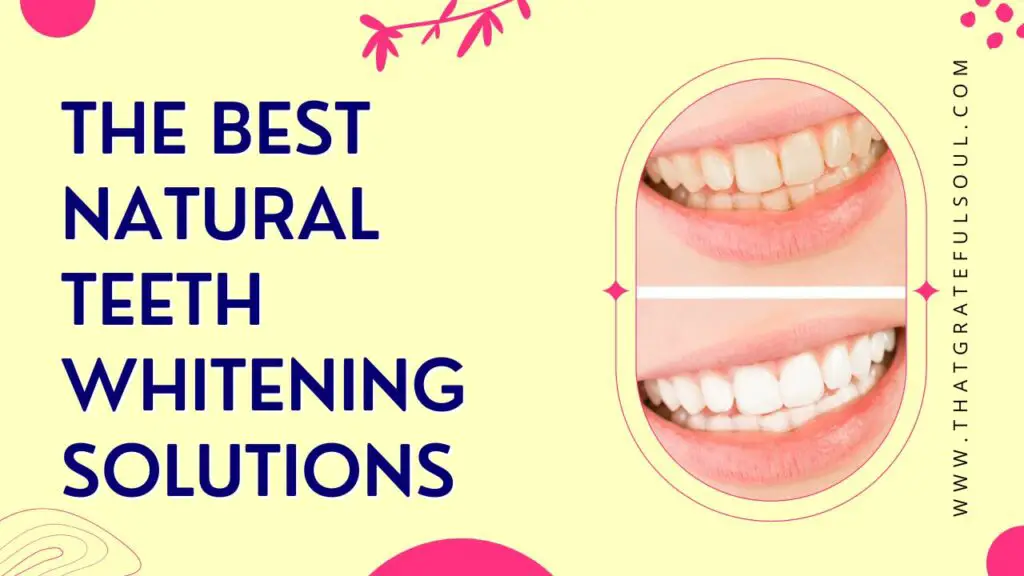Numerous individuals aspire to achieve a bright, radiant smile as it is often perceived as an indication of good oral health and personal hygiene.
It is widely believed that the most effective method to attain this goal is through professional teeth whitening treatments; however, these procedures can be expensive and potentially harmful to tooth enamel.
Consequently, there has been a growing interest in investigating natural alternatives for teeth whitening that are not only cost-effective but also safe for long-term use.
With the increasing focus on holistic health practices and environmental consciousness, the search for natural teeth whitening solutions has become more prevalent among those who desire to benefit others by promoting eco-friendly and sustainable dental care practices.

-
Save
Table of Contents
The Best Natural Teeth Whitening Solutions
This article delves into various natural teeth whitening solutions that have garnered attention due to their effectiveness in removing stains and discoloration from the tooth surface.
These methods include the use of common household items such as baking soda, hydrogen peroxide, apple cider vinegar, activated charcoal, and coconut oil, as well as fruit-based remedies incorporating strawberries and lemons.
In addition to these topical applications, dietary changes and maintaining good oral hygiene play an essential role in achieving a brighter smile without resorting to harsh chemicals or invasive treatments.
By exploring these alternatives in depth along with their benefits and potential drawbacks, readers will gain valuable insights into how they can enhance their oral care routine while fostering environmentally responsible habits that contribute towards the greater good of society.
Baking Soda and Hydrogen Peroxide
A highly effective method for enhancing one’s smile involves the use of baking soda and hydrogen peroxide, both well-known for their remarkable ability to remove stains and brighten tooth enamel.
As opposed to commercially available teeth whitening products, these ingredients offer a more affordable and eco-friendly option, making them popular soda alternatives in DIY toothpaste formulations.
Baking soda, scientifically known as sodium bicarbonate, has long been used as a gentle abrasive agent that effectively scrubs away surface stains on teeth; however, several baking soda myths have emerged over time regarding its safety when used in oral care.
Contrary to these misconceptions, research confirms that baking soda is safe for regular use when combined with a liquid such as water or hydrogen peroxide.
The latter ingredient not only complements the stain-removal action of baking soda but also acts as an antimicrobial agent by killing bacteria responsible for bad breath and gum disease.
While it is essential to note the importance of peroxide safety – given that excessive concentrations may result in tissue irritation – using a diluted solution (typically around 3% concentration) ensures optimal results without causing harm.
By harnessing the synergistic effects of baking soda and hydrogen peroxide, individuals can achieve a brighter smile while simultaneously promoting overall oral health through their versatile uses.
Apple Cider Vinegar
Harnessing the power of acetic acid, apple cider vinegar emerges as a potent remedy for enhancing oral radiance by reducing stubborn stains and discoloration.
Apple cider rinses and vinegar toothpaste formulations have gained popularity due to their natural components and ability to remove surface stains from teeth.
When used in moderation, ACV enamel effects can be beneficial in promoting a brighter smile without causing significant damage.
Cider gargling benefits extend beyond mere whitening, as this practice may also assist in eliminating harmful bacteria that contribute to bad breath and gum disease.
Homemade ACV remedies, such as diluting the vinegar with water or combining it with baking soda before application, provide customizable solutions for those seeking alternative approaches to traditional dental care products while fostering an environment of altruism through sharing these accessible techniques with others.
Activated Charcoal
Utilizing activated charcoal as a dental care product has gained traction in recent years due to its adsorptive properties, which aid in the removal of surface stains and the potential enhancement of overall oral health.
Charcoal toothpaste, for example, is formulated with activated charcoal that binds to plaque and other impurities on the teeth’ surface, thereby promoting a brighter smile.
DIY charcoal masks using this ingredient can also be applied directly onto the teeth, offering an effective yet cost-efficient alternative to conventional whitening treatments.
In comparison with traditional whitening strips, activated charcoal exhibits fewer side effects while still delivering noticeable results.
Activated charcoal safety is another factor contributing to its popularity; since it is a natural substance derived from organic materials like coconut shells or wood pulp, it poses minimal risks when used correctly.
Furthermore, charcoal powder benefits extend beyond cosmetic enhancement: studies have demonstrated its ability to reduce harmful bacteria in the oral cavity as well as neutralize bad breath odors resulting from volatile sulfur compounds.
Hence, incorporating activated charcoal into one’s dental hygiene routine may serve not only aesthetic purposes but also contribute positively toward overall oral well-being.
Oil Pulling with Coconut Oil
Exploring the practice of oil pulling with coconut oil reveals its potential to improve oral health and hygiene while offering a gentle alternative to traditional dental care products.
Originating from ancient Ayurvedic medicine, this method involves swishing a tablespoon of coconut oil in the mouth for 15-20 minutes, which allows the oil’s natural properties to draw out toxins and bacteria.
Coconut benefits include its antimicrobial and anti-inflammatory effects that help reduce plaque buildup, gingivitis, and bad breath.
Furthermore, when performed regularly, oil pulling may contribute to teeth whitening by removing surface stains without causing tooth enamel erosion.
Swishing techniques should be practiced gently to avoid jaw discomfort or fatigue, ensuring that the process is both effective and enjoyable.
Overall, incorporating coconut oil pulling into one’s daily routine can foster a healthier oral environment while providing a sustainable and eco-friendly approach to dental care.
Fruit-Based Remedies: Strawberries and Lemon
Delving into fruit-based remedies, particularly strawberries, and lemon, reveals their potential for promoting oral health and hygiene, with a notable statistic indicating that 62% of people surveyed considered an attractive smile to be the most important feature when meeting someone new.
Strawberry rubbing is a technique that harnesses the fruit peel powder to whiten teeth due to its high content of malic acid; this enzymatic action breaks down surface stains on the enamel while providing essential nutrients for dental health.
Similarly, lemon juice gargling offers natural bleaching agents in the form of citric acid which gently erodes discolored tooth surfaces without causing damage when used in moderation.
The combined approach of these natural methods capitalizes on their unique properties, delivering noticeable results through minimally invasive means and satisfying the subconscious desire for serving others by contributing to their overall well-being in an environmentally conscious manner.
Turmeric Powder
Examining the potential of turmeric powder as a dental care remedy unveils its capacity to promote oral health and hygiene while providing an eco-friendly alternative to conventional teeth-whitening methods.
The benefits of turmeric stem from its active ingredient, curcumin, which exhibits antioxidant properties that aid in combating inflammation and reducing plaque buildup.
Furthermore, the abrasive nature of turmeric assists in stain removal and overall tooth polishing.
As a result, incorporating turmeric into daily dental routines through DIY toothpaste recipes can prove advantageous for individuals seeking natural alternatives to commercial whitening solutions.
Such recipes often include ingredients such as coconut oil and baking soda, which are blended with turmeric powder to create an effective yet environmentally-conscious solution for maintaining a healthy smile.
Utilizing turmeric-based dental care products not only fosters sustainable practices but also caters to those who prioritize altruism by offering an accessible and affordable option for teeth-whitening that is supportive of overall well-being.
Maintaining Good Oral Hygiene
In addition to the utilization of turmeric powder as a natural teeth-whitening solution, maintaining good oral hygiene plays an essential role in preserving the brightness and overall health of one’s teeth.
Incorporating various practices such as oral probiotics, tongue scraping, fluoride treatments, electric toothbrushes, and proper flossing techniques can significantly contribute to achieving optimal oral health.
Oral probiotics help maintain a balanced bacterial environment in the mouth while tongue scraping aids in removing bacteria that cause bad breath and discoloration.
Fluoride treatments strengthen tooth enamel and prevent cavities by remineralizing teeth surfaces.
Electric toothbrushes have been shown to be more effective than manual toothbrushes at removing plaque and improving gum health due to their advanced features like timers and pressure sensors.
Lastly, mastering effective flossing techniques ensures thorough cleaning between teeth, preventing plaque buildup which can lead to yellowing over time.
Emphasizing these aspects of oral care not only serves oneself but also contributes positively to others’ perceptions of an individual’s attentiveness toward dental hygiene maintenance.
Dietary Changes for a Brighter Smile
Adopting specific dietary modifications can also play a crucial role in enhancing the appearance and health of one’s smile.
Reducing sugar intake is essential, as excessive sugar consumption can lead to tooth decay and discoloration; it is prudent to limit candies, pastries, and sugary beverages to minimize these adverse effects.
Simultaneously, increasing calcium-rich foods such as milk, cheese, and yogurt fortify teeth enamel and help maintain their natural white color.
Drinking green tea has also been found to have numerous oral health benefits due to its antimicrobial properties that combat bacteria responsible for plaque formation.
Furthermore, avoiding staining beverages like coffee, red wine, and dark-colored sodas can aid in preventing unsightly stains on the teeth surfaces.
Lastly, chewing sugar-free gum stimulates saliva production that aids in neutralizing acids produced by bacteria in the mouth; this practice not only freshens breath but also promotes healthier teeth and gums over time.
Conclusion
In conclusion, achieving a radiant smile without resorting to harsh chemicals is indeed attainable through the aforementioned natural teeth whitening solutions.
These remedies, ranging from baking soda and hydrogen peroxide to dietary changes, provide a holistic approach that addresses not only the cosmetic aspect but also promotes overall oral health.
As the adage goes, “A smile is worth a thousand words.” Thus, investing time and effort in maintaining a brilliant set of pearly whites will undoubtedly yield immeasurable benefits for one’s self-confidence and well-being.
-
Save

